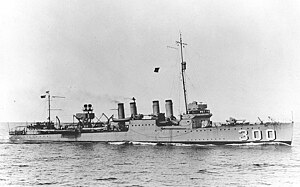USS Farragut (DD-300)
 USS Farragut (DD-300)
| |
| History | |
|---|---|
| Namesake | David Farragut |
| Builder | Bethlehem Shipbuilding Corporation, Union Iron Works, San Francisco |
| Laid down | 4 July 1918 |
| Launched | 21 November 1918 |
| Sponsored by | Marie Charlier Potts |
| Commissioned | 4 June 1920 |
| Decommissioned | 1 April 1930 |
| Stricken | 22 July 1930 |
| Fate | Sold for scrap, 31 October 1930 |
| General characteristics | |
| Class and type | Clemson-class destroyer |
| Displacement |
|
| Length | 314 ft 4 in (95.8 m) |
| Beam | 30 ft 11 in (9.42 m) |
| Draught | 10 ft 3 in (3.1 m) |
| Installed power |
|
| Propulsion | 2 shafts, 2 steam turbines |
| Speed | 35 knots (65 km/h; 40 mph) (design) |
| Range | 2,500 nautical miles (4,600 km; 2,900 mi) at 20 knots (37 km/h; 23 mph) (design) |
| Complement | 6 officers, 108 enlisted men |
| Armament |
|
USS Farragut (DD-300) was a Clemson-class destroyer built for the United States Navy during World War I.
Description
The Clemson class was a repeat of the preceding
Performance differed radically between the ships of the class, often due to poor workmanship. The Clemson class was powered by two
The ships were armed with four
Construction and career
Farragut, named for Admiral
It was sponsored by Marie Charlier Potts, wife of Templin Morris Potts, and launched on 21 November 1918. On 4 June 1920, it was commissioned.[5][6][7]
Farragut arrived at
In both 1924 and 1927, Farragut sailed into the Caribbean for fleet concentrations for maneuvers, in 1927 continuing north to visit New York, Newport, Rhode Island, and Norfolk, Virginia. Her first visit to the Hawaiian Islands was in the summer of 1925, during which she acted as station ship during the flight of seaplanes from the west coast to Hawaii. Again in the spring of 1928 Farragut exercised in the Hawaiians.
USS Farragut was decommissioned at San Diego on 1 April 1930, stricken from the Naval Vessel Register on 22 July 1930 and sold for scrap on 31 October 1930 in accordance with the London Naval Treaty.
Citations
- ^ Gardiner & Gray, p. 125
- ^ Friedman, pp. 402–03
- ^ Friedman, pp. 39–42, 402–03
- ^ Friedman, pp. 44–45
- ^ Ships of the United States Navy and Their Sponsors, 1913-1923. The Plimpton Press. 1925. p. 70. Retrieved 1 December 2021.
- ^ "Farragut II (Destroyer No. 300), 1920-1930". navily.mil. 24 February 2016. Retrieved 1 December 2021.
- ^ "Lieut. Com. Potts a Bridegroom: Naval Attache in Berlin Married to Mrs. Alden Brown" (PDF). The New York Times. New York City. 11 May 1902. Retrieved 11 November 2010.
References
- Friedman, Norman (1982). U.S. Destroyers: An Illustrated Design History. Annapolis, Maryland: Naval Institute Press. ISBN 0-87021-733-X.
- Gardiner, Robert & Gray, Randal, eds. (1985). Conway's All the World's Fighting Ships 1906–1921. Annapolis, Maryland: Naval Institute Press. ISBN 0-85177-245-5.
- This article incorporates text from the public domain Dictionary of American Naval Fighting Ships. The entry can be found here.
